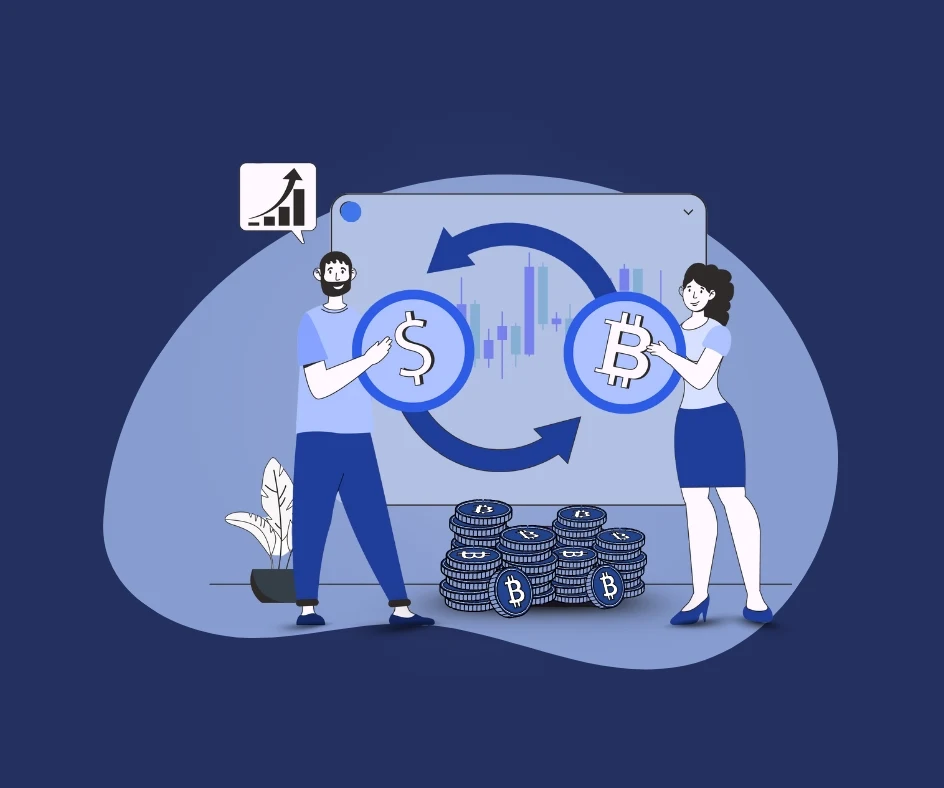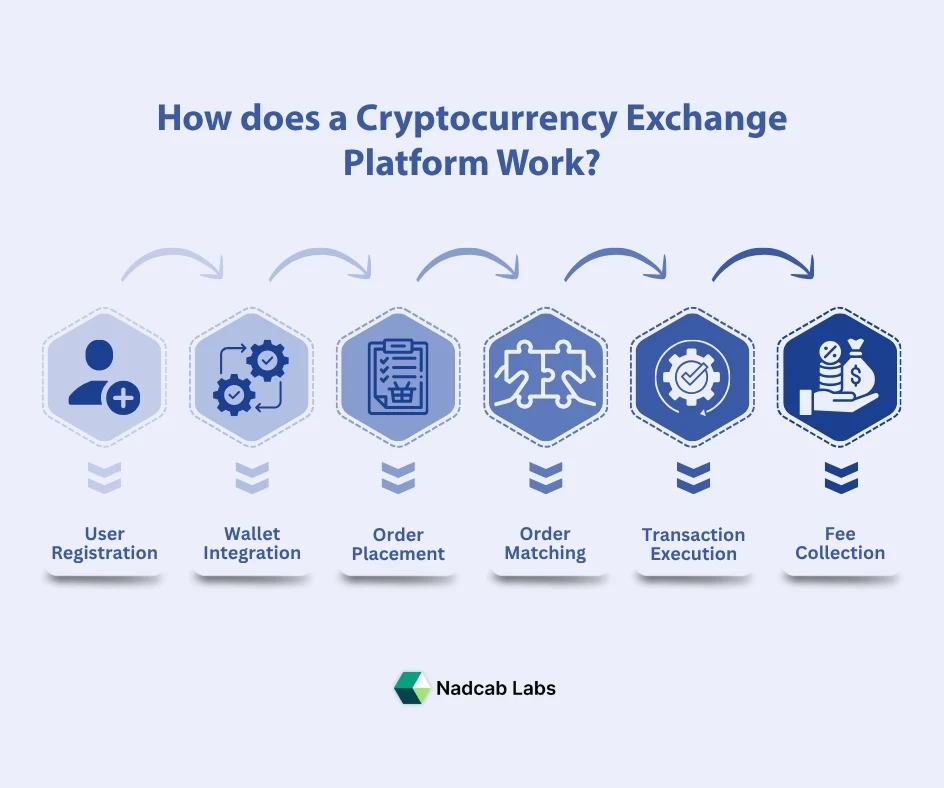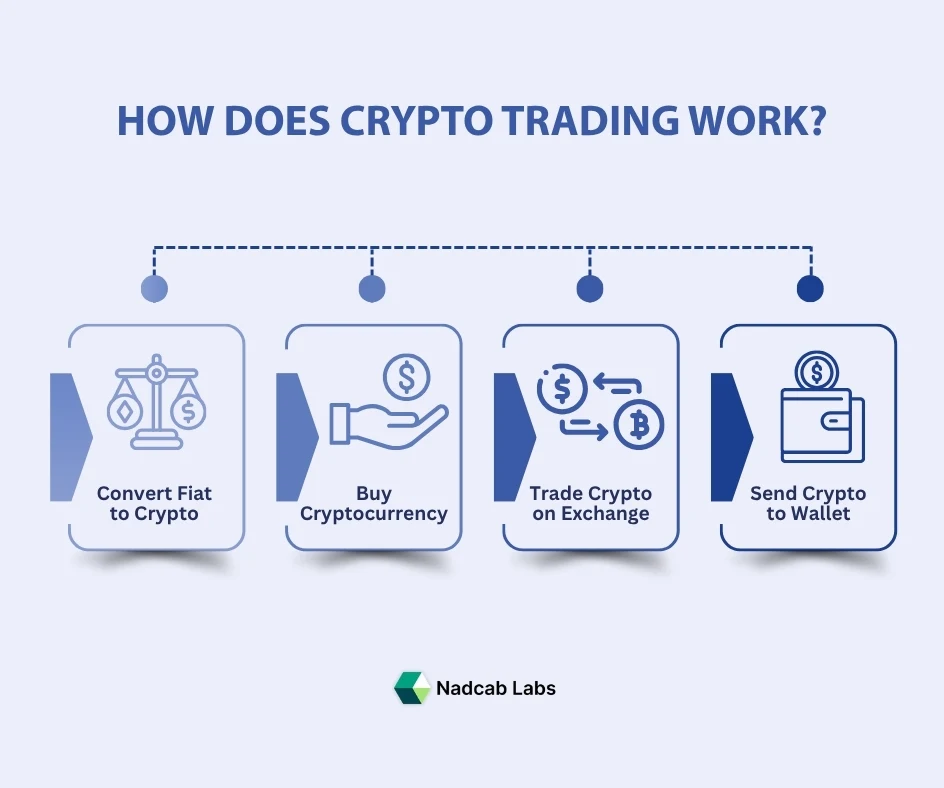
Imagine walking into a bustling digital marketplace, where instead of apples and oranges, people are exchanging digital assets like Bitcoin (BTC) or Ethereum (ETH) and cash. That’s essentially what a cryptocurrency exchange is: the gateway where buyers meet sellers, fiat meets crypto, and investment dreams meet reality.
But this is far from a simple equation. As the crypto-market has grown into a trillion-dollar industry, the institutions that power it are evolving, being regulated, hacked, innovated, and sometimes collapsing altogether. In this blog, we’ll unpack what a cryptocurrency exchange is, why they matter, how they work, the risks and benefits, and what you should look for if you decide to use one.
Defining a Cryptocurrency Exchange
At its core, a cryptocurrency exchange is a platform, online or otherwise, that allows users to buy, sell, trade, or convert cryptocurrencies for other assets (either fiat currencies like USD, EUR, INR, or other cryptocurrencies).
From the description on Investopedia:
“Cryptocurrency exchanges are online platforms … that make it convenient for users to purchase and sell cryptocurrency.”
From Corporate Finance Institute:
“Platforms that facilitate the trading of cryptocurrencies for other assets, including digital and fiat currencies.”
Thus, if you hold INR in a bank, deposit it into an exchange, and purchase BTC, you’ve used a cryptocurrency exchange.
Also Read: What Is Cryptocurrency & how does it work
Why They Matter- Context & Scale
To fully appreciate the role of exchanges, consider some of these figures:
- According to Hedera Hashgraph’s Learning Center, cryptocurrencies have grown into a US$1.50 trillion industry.
- The very existence of exchanges enables the “asset class” element of crypto – you need a marketplace to buy and sell.
- The dynamics of exchanges influence liquidity (how easily you can buy/sell without shifting price), volumes, and even the design of tokens (some tokens are listed only on certain exchanges).
- On the regulatory front, exchanges are often the “on-ramp” between traditional finance and crypto; hence, they become focal points for oversight, compliance, and risk.
In short, without exchanges, cryptocurrencies would largely remain oddities, limited to niche swaps or dark webs. Exchanges bring mainstream accessibility, visibility, and the full force of price discovery.

Types of Exchanges & How They Work
Not all exchanges are created equal. Two broad categories dominate:
1- Centralized Exchanges (CEX)
These are traditional style platforms: a company owns and runs them, users deposit funds, and the exchange takes care of matching trades, custody (in many cases), and account access.
Advantages:
- Generally more user-friendly; good for beginners.
- Typically higher liquidity (lots of buyers & sellers).
Disadvantages:
- You often give up some control (custody), and your funds may be held by the exchange.
- They are targets for hacks, regulatory action.
2- Decentralized Exchanges (DEX)
These use smart contracts and blockchain protocols to facilitate peer-to-peer trading without a central operator holding your funds.
Advantages:
- Greater control by the user (you often keep custody).
- Often more privacy.
Disadvantages:
- Lower liquidity than big CEXs.
- More technical to use; may have fewer fiat-on-ramps.
How they work (simplified):
- Account & Verification (for many CEXs) – Know Your Customer (KYC) / Anti-Money Laundering (AML).
- Deposit Funds – Either fiat (via bank transfer/card) or crypto.
- Order Placement – You choose, e.g., to buy ETH with INR or trade ETH for BTC.
- Matching Engine – The exchange matches your buy with someone’s sell (CEX) or executes a smart contract (DEX).
- Withdrawal – You take your crypto out to a personal wallet, or withdraw fiat back to your bank.
- Fees – Exchanges make money via trading fees, spread, withdrawal fees, and listing fees.
The Benefits of Using an Exchange
Leveraging a crypto exchange brings several advantages:
- Accessibility– Makes it feasible for everyday users to participate in crypto markets (rather than needing to run a full node, set up mining, etc.).
- Liquidity– Because many users trade, you can often get in and out quickly (especially with major coins).
- Variety of Assets– Many exchanges support dozens or hundreds of coins and tokens, giving exposure to different projects.
- Fiat-On-Ramp– Some exchanges let you deposit fiat currencies, so you don’t need to already hold crypto.
- Tools & Services– Beyond simple buy/sell, many offer advanced features: limit orders, derivatives, staking, etc.
- User Experience– Especially CEXs are designed with UX in mind, including dashboards, mobile apps, and tutorials.

Read More: How to buy Bitcoin
The Risks and Challenges
For all their merits, crypto exchanges come with significant risks. Being aware of them is critical if you want to proceed safely.
1- Custody & Trust Risk
If you deposit funds into a CEX, you are trusting the exchange with your assets. If the exchange is hacked, mismanaged, or insolvent, your funds are at risk. The infamous collapse of FTX in 2022 is a prime example: an $8 billion hole in accounts triggered massive withdrawals and bankruptcy.
2- Security Risk
Large exchanges store huge sums of crypto and fiat, making them targets for hackers. Even decentralized platforms are vulnerable (via smart contract bugs).
3- Regulatory and Compliance Risk
Exchanges operate in multiple jurisdictions, with varying regulations (or lack thereof). This means you could face service interruptions, legal risks, or regulatory actions.
4- Liquidity and Market Risk
Not all markets are liquid. On smaller exchanges or for smaller tokens, you may struggle to exit a position without impacting the price. On DEXs, especially, low liquidity can be an issue.
4- Hidden Fees / Complexity
Fees can eat into returns – trading fees, withdrawal fees, spreads. Also, the interface and features may be complex for beginners.
5- Scam Risk
Fake exchanges, phishing sites, and unregistered platforms pose a danger to users. A 2020 academic study found thousands of scam domains and fake apps posing as crypto exchanges.
Launch Your Exchange Today
Partner with Nadcab Labs to develop a high-performance crypto trading platform.
What to Look for When Choosing an Exchange
If you’re considering using a crypto exchange, here are key factors (supported by expert sources) to evaluate:
- Reputation & Track Record– How long has the exchange been operating? Have there been major issues (hacks, legal troubles)? What is their response?
- Regulation & Compliance– Does the exchange adhere to local laws? Does it implement KYC, AML? Is it registered/licensed where required?
- Security Measures– Cold storage of funds, two-factor authentication (2FA), insurance cover, and auditing practices.
- Asset Selection– Which cryptocurrencies are supported? Any fiat on-ramp?
- Fees– Transparent fee schedule for trading, deposits, and withdrawals.
- Liquidity & Volume– Higher volumes often mean tighter spreads and easier trading; check market data.
- User Experience & Trustworthiness– UX design, help/support, transparency of ownership, corporate communication.
- Withdrawal Options– How easy and fast is it to withdraw your funds (fiat/crypto)? Are there hidden limits?
- Custody Choices– Does the exchange allow you to withdraw to your own wallet (important for control), or keep funds locked?
- Customer Support & Education– Helpful resources, tutorials, and responsive support add to trust.
For example, Investopedia emphasizes verifying physical address, checking for regulations as the first steps.
Role & Future Outlook
What role do exchanges play in the broader crypto ecosystem – and where might this go?
1- Bridge between TradFi and Crypto
Exchanges allow traditional investors (retail or institutional) to access digital assets. As more regulatory frameworks emerge globally, they will play the pivotal role of regulated on-ramps.
2- Innovation Platforms
Many exchanges now host token listings, Initial Exchange Offerings (IEOs), and other asset-launch platforms. The concept of an “Initial Exchange Offering” is essentially a token fundraising done via an exchange platform.
3- Decentralization Pressure
As crypto matures, we’re seeing the rise of decentralized exchange models, peer-to-peer models, non-custodial trading, and the clash between the convenience of CEXs and the sovereignty of DEXs. Future exchanges may blend these elements (hybrid models).
4- Regulatory Evolution
Governments are increasingly regulating exchanges: registration requirements, AML/KYC regimes, supervision of custody, and consumer protection. This is likely to increase trust and reduce risks in the long run.
5- Integration with DeFi and Web3
Exchanges may evolve from just “swap platforms” into broader ecosystems: combining trading, staking, lending, liquidity provision, cross-chain swaps, and interoperability services.

A Simple Walk-through Example (Using One)
Let’s say you want to buy crypto via an exchange:
- You choose a regulated exchange that serves India (or allows INR deposits).
- You create an account, complete KYC (upload ID, photo).
- You deposit INR via bank transfer or UPI.
- On the platform, you select, say, an INR-BTC trading pair: Buy BTC@₹X.
- Your trade is executed, you may hold BTC in the exchange wallet (custody) or choose to withdraw it to a personal wallet (preferred for control).
- Later, you want to sell BTC for INR: you place a sell order, funds go back to your exchange account, then you withdraw to your bank.
- Throughout, you check fees, verify withdrawal terms, and keep an eye on market liquidity and security.
This simplified process hides nuances (for example, limits, deposit time, tax implications) but gives a practical route.
9. Final Thoughts: Key Takeaways
- A cryptocurrency exchange is an essential part of the crypto ecosystem, the place where buying, selling, and trading happen.
- They provide accessibility and liquidity, but come with risks (custody, security, regulation).
- Using an exchange demands the same scrutiny you’d apply to any financial intermediary: reputation, regulation, security, and transparency matter.
- The field is evolving: decentralized models, stronger regulation, and new services are transforming how exchanges work.
- For you, as an end-user or investor, focus on safety, understanding the platform, and aligning with your objectives (long-term hold vs short-term trade).
In Summary
If you think of the crypto world as a new frontier of digital finance, the cryptocurrency exchange is its central marketplace. With trillions of dollars now flowing in, choosing the right gatekeeper matters immensely. Approach with curiosity, but also with caution. Knowledge and diligence are your best allies.
Crypto Exchange vs Wallet: What’s the Difference?
A crypto exchange lets you buy or sell coins, while a wallet safely stores them. Use exchanges for trading and wallets for secure long-term storage.
Centralized vs Decentralized Exchanges: Which Is Better?
Centralized exchanges are easier to use and highly liquid, while decentralized ones offer better privacy and control. The best choice depends on whether you value convenience or autonomy.
How to Choose the Best Cryptocurrency Exchange in 2025
Choose an exchange with strong security, regulatory compliance, and transparent fees. Look for high liquidity, good user reviews, and responsive support before trading.
What Is Liquidity in Crypto Exchanges and Why Does It Matter?
Liquidity means how easily assets can be traded without affecting price. High liquidity ensures faster trades and better prices, making exchanges more efficient for users.
Risks of Using Cryptocurrency Exchanges and How to Avoid Them
Crypto exchanges face risks like hacks, scams, and mismanagement. Always use verified platforms, enable 2FA, and store large funds in secure personal wallets.







